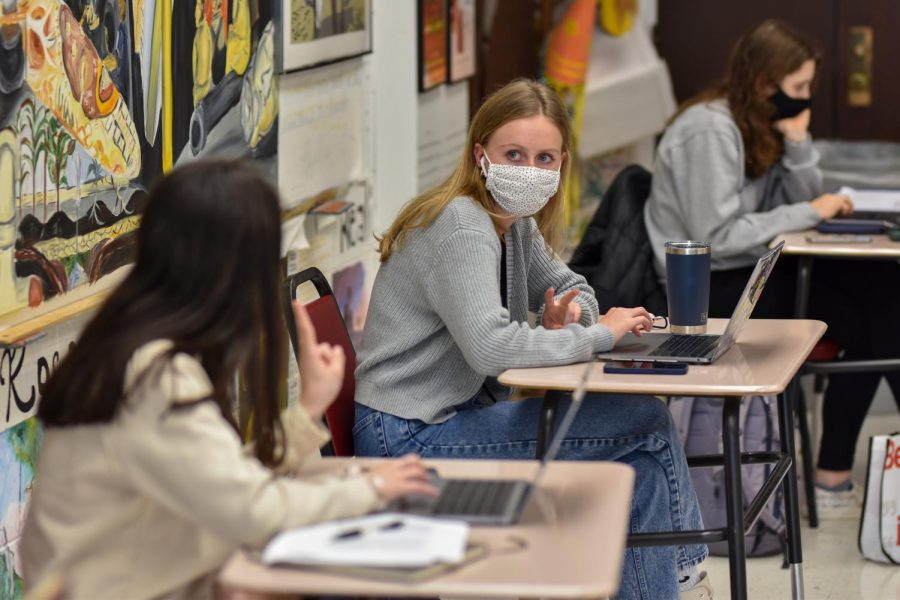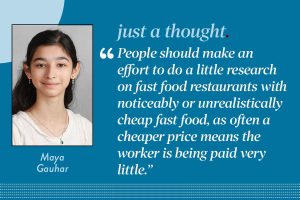In-person students face challenges of establishing rigor of school-day routine
Junior Izzy Cafferelli talks to friend during in-person class on historical campus.
April 15, 2021
The return to in-person learning brings back the routine of waking up early to commute to school, trekking down hallways and talking to friends. After more than a year of isolation, students are beginning to reclaim aspects of pre-pandemic conditions, now mixed with masks, social distancing and hand sanitizer.
Hybrid learning has allowed students to benefit from learning in a structured environment and socializing with others, but students face the challenges of reestablishing the rigorous school-day routine.
Ninth grader Hannah Shubin said, “I think that, like, being hybrid has been really good emotionally because you get the part about staying home and being comfortable, if you do enjoy that part, but you also get the luxury of going to school and seeing people and meeting your teachers.”
While in-person learning has emotional benefits for her, Hannah said transitioning to hybrid has reminded her of how energy consuming a school day can be after developing a less structured routine during distance learning.
“I’ve kind of had respect for being online because after being in person again, I realized, kind of, how tiring it was then to have to wake up early in the morning and go to your classes,” Hannah said.
Beyond routine changes, another readjustment Hannah made was catching up with friends face to face in the first few days on campus.
“I feel like it was a little bit awkward at first, just like actually seeing them in person instead of seeing them, their screen or texting them, but it was also nice because I feel like we had a lot more to talk about now.”
Counselor Michael Bruner noted that it takes time for students to adapt to a new routine and that the transition from distance learning to hybrid can be a source of stress.
“I think one of the biggest stressors is midstream having to make an adjustment,” Mr. Bruner said. “Again, again establishing those new routines, reorienting or orienting oneself for the first time to the building and the classrooms.”
While hybrid learning resembles school before the pandemic, sophomore Maile Nacu notes how it still feels isolating and falls short of expectations for some students due to social distancing restrictions.
“During lunch, it’s a lot different because usually that’s a time where you’re social with your friends and stuff, but with the six-foot distance and the silent lunch period, it’s like the dynamic is a lot different,” Maile said. “It kind of feels like a study period type of thing.”
Due to the limited opportunities to socialize with friends during the school day, Maile said that some students question whether hybrid learning is worth the extra time of going on campus and the stress of having to finish homework later.
“I feel like some people still felt, kind of, still isolated at school because you still have to be kind of far from people and there’s like not that much time in the day to talk to people,” Maile said.
According to Mr. Bruner, students also miss aspects of communication such as facial expressions and touch while following social distancing and wearing masks. Lacking the opportunities to give hugs and high fives may deprive students of the familiarity of socializing with friends.
“I can be smiling right now or I can be frowning right now,” Mr. Bruner said. “You miss a lot of what I’m saying without the other parts when your face is covered up.”
Despite the shortcomings of hybrid learning, students also find benefits in coming out of isolation. Stuck during distance learning, Hannah said that the routine of getting up early and following a schedule throughout the school day has increased her productivity.
“I didn’t go outside a lot. I kind of stayed home,” Hannah said. “I didn’t really do anything at all, and in terms of like school work and stuff, I was kind of not doing great for that either just because I was just kind of stuck.”
Senior Antonio Gracias noted how hybrid learning gives him the opportunity to talk with students outside of his closest friend circle and family.
“When I spent, like, the first three months of quarantine in like super close isolation with my siblings, you know, things started to get tense,” Antonio said, “and I think that that can happen when you talk to the same group of people over and over and over again.”
Compounding the effects of the isolation, sophomore Charlotte Henderson said that the way social media functioned as a highlight reel for its users made her feel even worse seeing her friends display the best aspects of their lives.
“On the one hand, social media is the only way we can connect to people our age, but on the other hand, it’s very toxic, and it kind of, you know, worsened everything.”
With hybrid learning expanding to accommodate students attending in person four days a week after seniors leave for May Project, Mr. Bruner said that students will continue trying to adjust to their new routines.
He said, “We’re pretty much going to spend the rest of the year just trying to get through this, just trying to find out where that equilibrium is for us each as individuals.”




























































